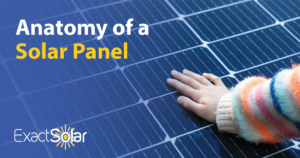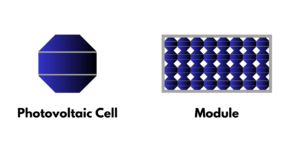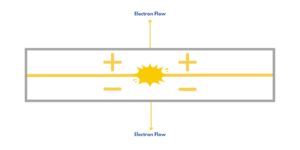Basics of the Solar Panel
If you’ve ever thought to yourself, “How do solar panels actually work?” – you’re not alone!
The concept of harnessing the sun’s power for energy is not new, but the technology sure has come a long way. In the 7th century B.C., humans used glass and mirrors to light fires. Now, all across the globe, we use solar panels for affordable and clean energy.
Taking the leap into the world of solar can be intimidating. That’s why the first step in your journey should be to learn about and understand how panels work in the first place. Once you gain more knowledge about the topic, solar will seem a lot less daunting.
What Are Solar Panels Made Of?
Photovoltaics, also known as PV, are cells utilized in solar panels. When the sun shines onto the panel, the PV cells absorb that energy. This interaction creates electrical charges that move within the cell’s electrical field.
There are four terms that you will often hear when discussing solar – PV cells, modules, panels, and arrays. PV cells are what we touched on above and are connected together to form a working circuit known as a “module.” One or more modules are then assembled together as a pre-wired, field-installable unit called a “panel.” A photovoltaic “array” is the complete power-generating unit, consisting of any number of PV modules and panels.
When you break it down, solar panels are like sandwiches. Each “slice” is made up of semiconducting material – usually silicon. Photovoltaic cells establish an electric field to work. Similar to a magnetic field, an electric field occurs when opposite charges are separated. To achieve this, materials are added to both sides of the “sandwich” to create a positive and negative charge.
From there, an electric field is created at the junction between the silicon layers. Light is composed of photons, which are simply small bundles of electromagnetic radiation or energy. When light of an acceptable wavelength hits these cells, energy from the photon is transferred to an atom of the semiconducting material in the junction. Thanks to this reaction, electrons flow out of the junction between cell layers, resulting in an electrical current.
How Does This Create Energy in the Solar Panel?
After electrons are pushed out of the junction, a few things need to happen to create usable electricity.
Metal conductive plates that are on either side of the cell collect the electrons and transfer them to wires. The electrons can then flow like any other source of electricity. This is known as the photovoltaic effect. Electrical conductors are attached to the positive and negative sides of the cell to form an electrical circuit and the electrons are then captured in the form of an electric current. This current is extracted through conductive metal contacts – the grid-like lines you see on solar cells – and is then used to power your home.
What Does Efficiency Mean for My Solar Panels?
Solar panel efficiency, the ability of a solar panel to convert sunlight into electricity effectively, measures how much sunlight the panel can convert into usable electrical power. Efficiency is expressed as a percentage and represents the ratio of the electrical output power generated compared to the amount of sunlight energy that hits the panel. For example, if a solar panel has an efficiency of 20%, it means that it can convert 20% of the sunlight it receives into electricity, while the remaining 70% is not captured.
Over the past few decades, the efficiency of solar panels has steadily increased and is projected to continue on that trend as technology advances. Efficiency can be affected by various factors, including the type of solar cell technology used, quality of materials, temperature, shading, and the angle of the panels towards the sun.
Exact Solar Is Here to Help With Your Solar Needs
With 18 years of experience in the industry, Exact Solar is here to guide you through your solar journey. Our team is comprised of knowledgeable and professional sales engineers who will answer any questions you have and work with you through the entire process. When you’re ready to get started, please give us a call at (215) 621-8353 or connect with us on our website here.





